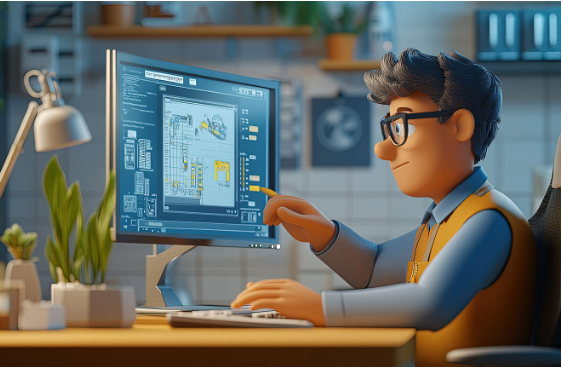When you look at a stunning piece of concept art or a meticulously crafted 3D model, it’s easy to admire the detail, the colors, and the creativity that went into its design. But what many don’t see is how these individual pieces of art transform into immersive, playable game worlds. The bridge between static creativity and interactive experiences is built by an AAA game art studio that knows how to transform a game art portfolio into a living, breathing universe.
In today’s gaming industry, players expect more than just entertainment. They want experiences that feel alive, worlds that invite exploration, and stories told not only through dialogue but through every pixel and texture on the screen. Achieving this requires more than isolated pieces of artwork—it demands a vision where every portfolio piece serves as a building block for a cohesive game world.
From Individual Pieces to Immersive Environments
Every game art portfolio begins with fragments: sketches of characters, environment designs, weapon models, or animation studies. Alone, these elements are impressive, but their true potential lies in integration. An AAA game art studio takes these fragments and weaves them into a seamless visual tapestry.
For instance, an environment sketch of a dystopian cityscape doesn’t just remain a 2D drawing. Through 3D modeling, texturing, and lighting, it evolves into an explorable space filled with atmosphere and emotion. The portfolio becomes more than proof of artistic skill—it becomes the DNA of a playable world.
The magic lies in how these assets connect. A character design might showcase clothing inspired by a certain culture, and that influence extends to the architecture and props in the environment. When these details align, the world feels believable and immersive. That’s the ultimate measure of success in game art: when the player forgets they’re in a game and feels like they’ve stepped into another reality.
The Role of Storytelling in Game Art Portfolios
What sets apart a functional game art portfolio from a truly inspiring one is storytelling. Every asset should communicate a fragment of the game’s larger narrative. A rusted sword isn’t just a weapon—it tells a story of battles fought. A neon-lit alleyway isn’t just an environment—it hints at a city’s culture, economy, and hidden dangers.
AAA game art studios focus heavily on narrative-driven portfolios. This is because players engage most deeply with games that feel like stories unfolding around them. When art assets are created with storytelling in mind, the resulting game doesn’t just look good; it resonates emotionally.
Bridging Creativity and Technology
Another challenge in turning portfolios into playable worlds lies in technology. A piece of concept art may be visually stunning, but it has to be optimized for real-time rendering within game engines like Unreal or Unity.
Here, the expertise of an AAA game art studio shines. Artists and technical teams work together to preserve the artistic vision while ensuring that assets load quickly, run smoothly, and meet the performance demands of various platforms. This delicate balance of creativity and technical execution is what transforms a visually rich portfolio into a functional, interactive experience.
Collaboration: The Secret Ingredient
A portfolio might be an individual’s showcase, but turning it into a playable world is never a solo effort. In AAA studios, teams of concept artists, 3D modelers, texture artists, animators, and lighting experts collaborate seamlessly.
Consider a character design: one artist sketches it, another builds the 3D model, another textures it, while yet another ensures it animates naturally. Each step is a layer of collaboration that brings depth and life to the final in-game character. The same principle applies to environments, props, and visual effects. It’s this collective effort that breathes life into the portfolio’s raw potential.
Why Portfolios Matter for Studios and Players
For aspiring game artists, portfolios are often seen as tools for employment. But within studios, they serve a larger role. A strong game art portfolio acts as a blueprint for a project’s visual identity. It’s both a showcase and a guide—a way to ensure every team member is aligned with the creative vision.
For players, the benefits are indirect but significant. When studios translate well-crafted portfolios into their games, players enjoy experiences that feel polished, consistent, and immersive. They may not know the countless hours behind every texture or character rig, but they feel the results when they get lost in a world that feels real.
The Future of Game Art Portfolios
Looking ahead, the evolution of portfolios will only grow more exciting. With advancements in AI-driven tools, real-time rendering, and virtual production, portfolios are no longer just static collections of images. Many artists now present interactive portfolios that allow viewers to explore environments in 3D, rotate character models, or even walk through scenes in VR.
For AAA studios, this opens the door to building playable prototypes faster than ever before. A game art portfolio could eventually become the first draft of an actual game world, shortening production timelines while expanding creative possibilities.
Final Thoughts
At its core, the transformation of a game art portfolio into a playable world represents the essence of game development: creativity meeting interactivity. An AAA game art studio doesn’t just showcase beautiful designs—it builds universes where players can lose themselves, forge memories, and experience stories like never before.
In this process, every sketch, model, and texture is more than art; it’s a stepping stone toward immersion. And as technology continues to evolve, the line between portfolio and playable world will blur even further—reminding us that in the gaming industry, art is never static. It’s alive, interactive, and always waiting for players to step inside.
